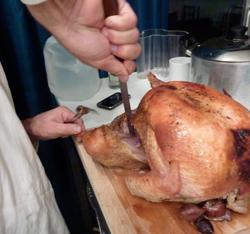
Making your own gluten-free turkey gravy for your Thanksgiving dinner gives you freedom to create a sauce which highlights flavors you prefer while making a food which you can add to your gluten-free repertoire. Most of the time you will need to make your gravy is included in the prep. After that, your base will simmer away as you prepare the rest of your meal.
Basic Components of Gluten-Free Turkey Gravy
Variations of turkey gravy are endless, let alone the gluten-free options. Whatever recipe you choose, you will undoubtedly begin with a basic mirepoix. A mirepoix is a mixture of chopped vegetables. This mixture typically includes ingredients such as chopped carrots, celery, onion, and other additions.
You can either use your mirepoix raw or sautéed in your preferred fat, whether the fat is oil or butter. If you sauté your vegetables, sauté them to the caramelized stage for maximum flavor. This stage is marked by a deep, rich brown color caused by the cooking of the mirepoix's sugars. Salt the vegetables lightly. Using sautéed vegetables is preferable for maximum flavor. It will also add lovely color to your gravy.
In addition, you can sauté other ingredients such as the gizzard and other innards of the turkey. These components have lots of flavor with which you can take advantage of in a gluten free way. It will also help mirror the flavors of your turkey. Chop the meat to a small dice for quicker cooking. Alternatively, you can use these turkey parts for preparing stock.
Stock Preparation
The next step toward creating your gluten-free turkey gravy is the stock. Basic ingredients will include your mirepoix, either sautéed or raw, and the innards of your turkey. For added flavor, include some parsley, whole peppercorns, and thyme sprigs. If your turkey features other spices such as rosemary, feel free to add a sprig or two of these as well. Cover all the ingredients with water or a gluten-free chicken stock like Swanson.
Generally, the larger your vegetable pieces, the longer your stock needs to simmer for peak flavor. If you use a slow cooker for your stock, you can extract the most flavor from your ingredients. For poultry based gravy recipes, plan on 4 to 6 hours at the high setting. You can also let your stock simmer on the stove as your turkey cooks. If you have leftovers, you can freeze them and use them for other recipes.
Finishing the Gravy
After the appropriate amount of simmering, strain your stock through cheesecloth, making sure to squeeze the last bit of flavor from the ingredients. Then, place the strained stock in a 3-quart pan. You can throw in additional chopped parsley and thyme for a more flavorful gravy.While your turkey cooks, you should baste it with water or your prepared stock to seal in the juices. The drippings form the last ingredient of your turkey gravy. When the turkey is ready, remove it from the oven and place it on a cooking rack. Strain the drippings from your roaster and add them to your stock base.
The Final Product
This is where your gluten-free turkey recipe finally comes together. Continue to reduce the strained drippings and stock mixture. This helps concentrate flavors, giving your turkey gravy that welcome zing by increasing the intensity of flavors.
If you prefer a thicker gravy, cornstarch or xantham gum will suffice. Mix a tablespoon or two with some cold water. Then, simply add either ingredient to your reduced sauce base. You may want to let the gravy simmer for a few moments to thicken. You can then adjust your gravy for taste, adding salt and pepper as necessary. For a more tasty gravy, remove the meat from the gizzard and add it to your finished sauce.
Gravy is often as important as the turkey when it comes to a special meal. Making your own stock and gravy will make for a spectacular addition to your Thanksgiving meal.







